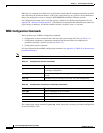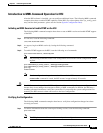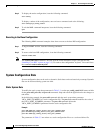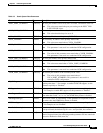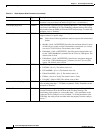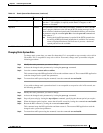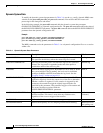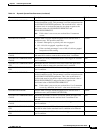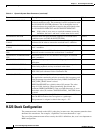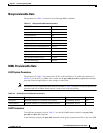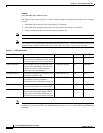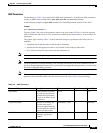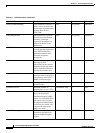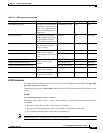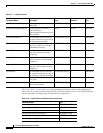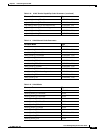
3-10
Cisco H.323 Signaling Interface User Guide
OL-4806-01 Rev. A14
Chapter 3 Provisioning the Cisco HSI
H.323 Stack Configuration
H.323 Stack Configuration
The parameter name is based on the ASN.1 paths; but, in some cases, the parameter name has been
shortened for convenience. For example, “capabilities” has been shortened to “caps.”
The case of the parameter name reflects exactly the ASN.1 definitions; but, case is not important to
MML configuration.
OVLDLEVEL3PERCENT Indicates what percentage of calls should be rejected when an
overload condition occurs. The parameter is used in conjunction with
the OVLDLEVEL3FILTER parameter. This is the highest level of
overload and must be greater than or equal to the provisioned values
for OVLDLEVEL1PERCENT and OVLDLEVEL2PERCENT.
Note If this value is set to zero, no overload treatment occurs (by
definition, the level 1 and level 2 values must also be zero).
90
OVLDLEVEL3FILTER Indicates what call types should be gapped if an overload level 3
condition occurs (see OVLDLEVEL1FILTER).
Normal
OVLDLEVEL3THRESHLOWER
CALLS
Determines the number of active calls below which the application
load must fall in order to remove the overload level 3 condition.
2300
OVLDLEVEL3THRESHUPPER
CALLS
Determines how many simultaneous active calls trigger an overload
level 3 condition.
2400
OVLDLEVEL3THRESHLOWER
CPU
Determines the level of CPU utilization below which the application
must fall in order to remove the overload level 3 condition.
85
OVLDLEVEL3THRESHUPPER
CPU
Determines the level of CPU utilization that triggers an overload
level 3 condition.
95
CIAGENTSCANPERIOD Specifies the frequency with which the CIagent polls the CPU
utilization.
—
ALARMDEBOUNCETIME Specifies the length of time that an alarm condition must persist
before being reported, and any associated action taken.
0
CALLREFERENCEUSAGE Determines which call reference identity is passed on to the
PGW 2200 (call reference field or Conference ID).
—
DISKUSAGELIMIT Represents a percentage of disk occupancy.
The application continually polls the system for disk occupancy, and
if the percentage rises above the limit set by DISKUSAGELIMIT, the
LOW_DISK_SPACE alarm is raised.
DISKUSAGELIMIT has a default value of 95 percent. The value
range is 0–100, inclusive. When dynamically provisioned, the
parameter DISKUSAGELIMIT, if not set within that range, is set to
the default value (95) and the CONFIGURATION_ FAILURE alarm
is raised.
95
RegFailureReleaseCause This parameter specifies the Q.850 release cause, which the HSI uses
after the HSI fails three times to register to a gatekeeper.
This parameter is assigned a value in the range 1—127
—
Table 3-4 Dynamic System Data Parameters (continued)
Parameter Description Default



